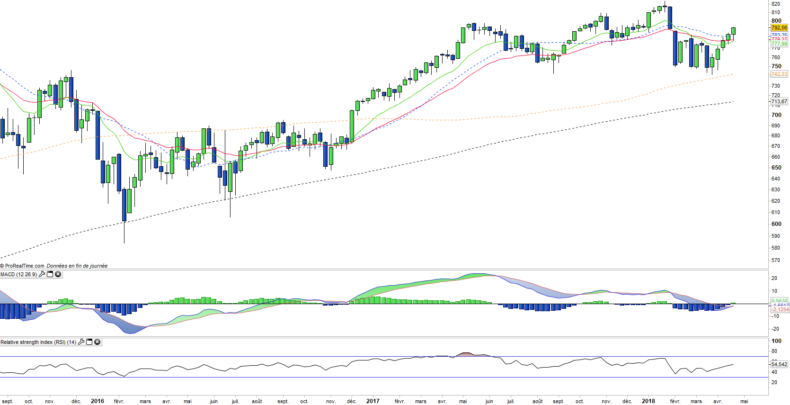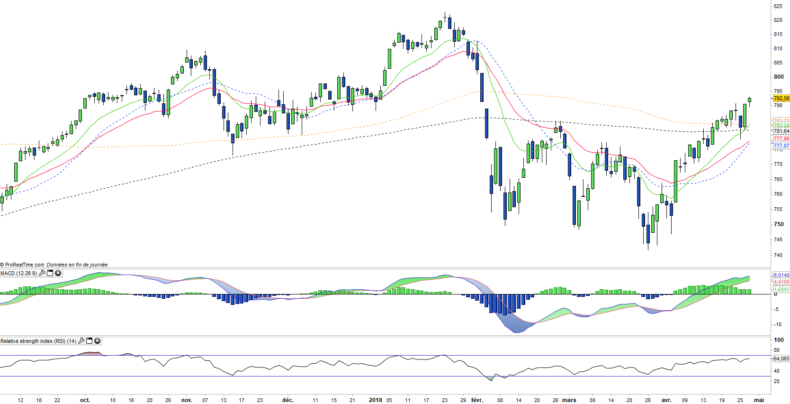Lyxor stoxx 600 Net Return (MEUD) - 30/04/2018
Short Term strategy: Positive (80%) / Trend +
Long Term strategy: Positive (60%) / Trend +
Characteristics of the ETF
The MEUD ETF (Lyxor) created in 04/2013 replicates the STOXX600 Net Return index which is composed of the 600 largest European stocks representative of the main sectors, while the stocks of the Euro zone represent approximately 53% of the index, there is therefore a significant exposure to other European currencies, in particular the British Pound and the Swiss Franc.
The fees of the ETF MEUD are quite low at 0.07% and the AUM is €1235M. Replication is direct (physical) and there is a dividend capitalization policy.
Alternative ETFs: C6E (Amundi in Euro), ETZ (BNP Theam in Euro), EXSA (iShares in Euro)
Latest developments
The Stoxx600NR finished the year 2017 on a rise of 10.6% justified by the double-digit corporate profits growth.
The year 2018 is reflected for the moment by a stability of the index, which reflects the effects of a correction coming from the US, linked to the fears of a trade war and a rise in US long-term rates, which make investors fear a return of inflation and a more restrictive policy of the FED.
However, the European cycle is less mature than the US cycle and valuations of the old continent are also more attractive at 15x earnings against 19x for the S & P500, while the rise in profits should be 8% in 2018. The ECB is about 2 years behind the Fed, which may leave a long enough window for a more restrictive liquidity policy in Europe.
The Euro / dollar parity is fairly stable between 1.2 and 1.25, which is a positive factor for European companies. The main risk for the European markets is certainly linked to the end of the US growth cycle, however this should not happen before the end of 2019 at the earliest, while the tax cuts of D.Trump have not still fully impacted earnings in 2018.
Index & components
The MEUD (Lyxor) tracker replicates the European benchmark, which enjoys a very important depth with 600 holdings and a great diversity by its exposure to the main sectors and countries of the European Union, including outside of the eurozone.
This index is a benchmark for the European markets, and we analyze its stock market behavior with great attention because the evolution of this index partly conditions our sectoral and geographic strategy.
The index is fairly balanced in its weighting with 4 major sectors that represent two thirds of the capitalization. In the first position is the cyclical and sustainable consumer goods sector (23.4%), which includes food giants such as Nestlé or AB-Inbev, as well as luxury, cosmetics and ready-to-wear brands like LVMH or Inditex as well as the automotive sector; financial (21.4%) industry (14.2%) and health (11.6%). In this index, energy-related values represent only 6.6% and raw materials 8.3%. In addition, it should be noted that there is a certain level of currency risk in this index consisting of 24.8% of British securities and 12.8% of Swiss securities, even if the securities concerned are international and fairly exposed to the dollar.
The STOXX600 is very representative of the European economy because of its sector weighting, which is less favorable to oil than in some national indices (like the CAC40), while the financial sector (banks + insurance) remains a key compartment with 21% of the weighting but without reaching the weight of the Italian or Spanish indices (c.33%). This balanced weighting allows MEUD to have lower volatility than the national indices, as this index is much more diversified and without sector bias. The ETF MEUD has the advantage of replicating a broader index than the Eurostoxx50 and which also incorporates smaller capitalizations, but with a more dynamic path.
The European economic cycle is currently being strengthened, which is validated both by the PMIs datas and also the results of companies above expectations in 2017. The ECB remains a factor of stabilization and the monetary normalization should be very progressive in the absence of inflation and despite the Bundesbank which would like a more restrictive policy, and the pressure linked to the rise in US long-term rates.
Weekly data
The weekly chart shows a bulish breakout from the benchmark European index. After repeatedly testing the weekly EMA100 and forming a fairly strong bottoming structure, the index accelerates upwards and confirms its reversal by going up on the EMAs 13 and 26. The weekly MACD is also turning around, which confirms the end of the correction.
Daily data
On the daily chart we can see the upward acceleration that is currently taking place on the index after several weeks of hesitation and non-directional moves. The prices are filling gaps left open during the correction of February, and should quickly reach the year highs at 820 pts. A more directional phase has probably started.
ETF Objective
MEUD is a UCITS ETF, listed in €, which seeks to replicate the STOXX Europe 600 (Net Return) index (600 european companies)
Characteristics
| Inception date | 03/04/2013 |
| Issuer | Lyxor |
| Expense ratio | 0,07% |
| Benchmark | Stoxx 600 |
| Ticker | MEUD |
| ISIN | LU0908500753 |
| UCITS | Yes |
| EU-SD Status | Out of scope |
| Currency | € |
| Exchange | Euronext Paris |
| Assets Under Management | 1247 M€ |
| Replication Method | Direct (Physical) |
| Dividend | Capitalization |
| PEA (France) | No |
| SRD (France) | No |
| Currency risk | Yes |
| Number of Holdings | 600 |
| Risk | 3/5 |
Country Breakdown
| United Kingdom | 25% |
| France | 17% |
| Germany | 15% |
| Switzerland | 13% |
| Netherlands | 6% |
| Spain | 5% |
| Sweden | 4% |
| Others | 15% |
Sector Breakdown
| Financials | 21% |
| Industrials | 14% |
| Consumer Staples | 12% |
| Health Care | 12% |
| Consumer Discretionary | 11% |
| Materials | 8% |
| Energy | 7% |
| Others | 15% |
Top Ten Holdings
| Nestlé | 2% |
| HSBC | 2% |
| Novartis | 2% |
| Royal Dutch Shell | 2% |
| Total | 2% |
| Roche Holding | 2% |
| BP | 1% |
| British American Tobacco | 1% |
| SAP | 1% |
| Siemens | 1% |


